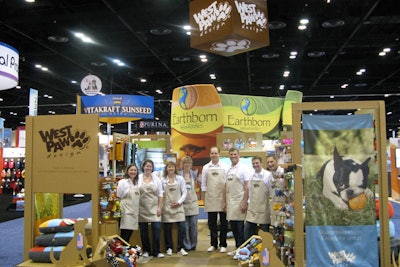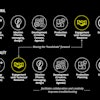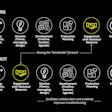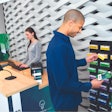
With more cost-effective sustainable materials now available, creating an eco-conscious exhibit is more affordable than ever. But building a new trade show booth from sustainable materials isn't the only way to go green. Here are five low- to no-cost ways to make your trade show booth more earth-friendly.
1. Keep it digital. Instead of printed materials, use QR codes and R.F.I.D. technology. “It’s a sustainable and efficient way to exchange information,” says Sue Tinnish, an assistant professor at Kendall College’s School of Hospitality Management in Chicago, where she teaches meeting management and sustainable tourism, and regularly speaks on the topic of sustainable meeting standards. At last year’s LightFair International show in Las Vegas, the Lighting Science exhibit by MG Design incorporated more than 80 QR codes, which were placed next to each product so visitors could connect to information like spec sheets and white papers, without the need for paper. For the 2012 North American International Auto Show in Detroit, Ford worked with Imagination to debut the R.F.I.D-enabled Ford Blue Oval Card. Guests preregistered the cards online, and could use them to save content on-stand to download later via a personal Web page. The company also created mobile apps that could be linked to the card, allowing users to collect full car specs in a virtual garage.
2. Turn off the lights. “A planner can require that exhibitors turn off and unplug equipment at the end of the show day, which saves on electricity,” says Tinnish. “Unlike changing the composition of a booth, a change in how business is conducted does not require any upfront investment at all.”
3. Avoid dates. Make sure that promotional items and booth giveaways do not include information like dates or locations of specific events that would prevent them from being reused at other events or promotional efforts. “Exhibitors can also choose promotional items that are made from recycled content or that are reusable, minimally packaged, biodegradable, or compostable,” says Tinnish.
4. Consider the reusability factors. The new eco-friendly booths are designed to be reused, with interchangeable graphics and easily reconfigurable sizes and skins, but also consider flooring options. “One of the biggest issues has been carpeting—exhibitors bring it in for a show and then leave it at the convention center, which throws it out,” says Eco Exhibits and Advatum Displays owner Doug Cornell, who says there are some eco-friendly companies now collecting the carpet from convention centers and recycling the fabric. “Don’t just throw carpet away,” says Tinnish. “Consider how you can reuse it, or talk to the general service contractor, the venue, and the exhibitor to see if you can promote an on-site donation program.” At the International Special Event Society New York metro chapter’s Sustainability Summit in April, Lee Ballin, who heads the sustainability efforts at Bloomberg LP, said among other eco-friendly trade show initiatives, the company reuses their booths’ carpet tiles, storing them in a warehouse between events.
5. Lighten up. Reducing the weight of an exhibit by using fabric or cardboard results in both reduced shipping costs and a smaller carbon footprint. Earlier this year, Antlre was asked to create an eco-friendly trade show exhibit for West Paw Design. The entire 20- by 20-foot footprint needed to be able to ship flat and to be completely recyclable. The winning design was made of 100 percent recycled cardboard, and the seven modular pieces were cut with solar-powered machinery by Bender Brothers. “Planners can also select a SmartWay transportation company,” says Tinnish. “SmartWay is a collaboration between the U.S. Environmental Protection Agency and the freight transportation industry that helps freight shippers, carriers, and logistics companies improve fuel-efficiency and save money—SmartWay is to transport like EnergyStar is to appliances.” Visit epa.gov/smartway for more information.


















